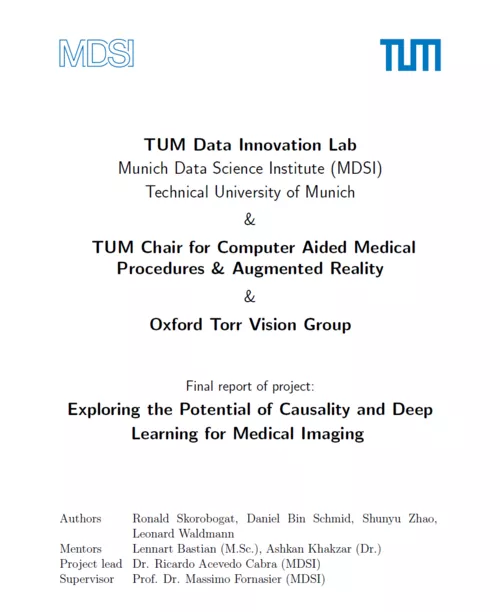Causal Graph Informed Deep Learning
Results of this project are shown in the final report (PDF) below:

- Sponsored by: TUM Chair for Computer Aided Medical Procedures & Augmented Reality (CAMP), and University of Oxford (Torr Vision Group)
- Project Lead: Dr. Ricardo Acevedo Cabra
- Scientific Lead: PhD candidate Lennart Bastian and Post-doc Ashkan Khakzar
- TUM Co-Mentor: Dr. Ricardo Acevedo Cabra
- Term: Winter semester 2023
- Application deadline: Sunday 23.07.2023
About the project:
Causal reasoning has been a cornerstone of predictive modeling in public health for some time [1]. More recently, there has been a growing interest in incorporating causal reasoning ability into multi-modal deep learning models to enhance interpretability and robustness [3]. While demonstrating promise on medical imaging benchmarks, such models have not been employed widely in the public health setting. Many open questions remain, such as how to contextualize data-driven models with domain expertise from physicians and epidemiologists.
This project aims to bridge the gap between causal reasoning and deep learning, paving the way for more interpretable, robust, and actionable models for prognosis in public health. By understanding the underlying causal structure, practitioners can simulate alternative scenarios of interventions, ultimately informing more effective treatment strategies for patients with e.g. alzheimers or lung disease [5]. Dynamically incorporating causal priors would enable leveraging the power of data-driven models from complex modalities while maintaining traditional causal interpretability and modeling capabilities.
Students will work at the intersection of causal reasoning and deep learning to better understand how to incorporate causal priors into learned models dynamically. In collaboration with experts in epidemiology from the UMIT University in Tirol, they will learn how domain experts leverage causal reasoning to shape public health policy. Subsequently, they will investigate how causal priors can be fused with deep learning models for developing flexible and interpretable frameworks that handle covariates from complex modalities such as images or genetic biomarkers [4]. As these topics are of high interest in the scientific community, a subsequent publication at prestigious venues such as MICCAI, IPMI, or MIDL could also be pursued.
Objectives:
1. Learn to construct causal knowledge graphs with our collaborating public health experts from UMIT University in Tirol.
2. Develop an understanding of causal reasoning and its potential to improve interpretability in deep learning models.
3. Investigate methods for integrating causal graphs as priors into deep learning models on simulated synthetic data [4].
4. Evaluate the developed models' interpretability, robustness, and practical applicability on a complex real-world Alzheimer’s dataset [2] or CMX-MIMIC [6], including dynamic counterfactual analysis without re-training.
References:
1. Glass, T. A., Goodman, S. N., Hernán, M. A., & Samet, J. M. (2013). Causal inference in public health. Annual review of public health, 34, 61-75.
2. Zheng, H., Petrella, J. R., Doraiswamy, P. M., Lin, G., & Hao, W. (2022). Data-driven causal model discovery and personalized prediction in Alzheimer’s disease. Npj Digital
Medicine, 5(1).
3. Vlontzos, A., Rueckert, D., & Kainz, B. (2022). A Review of Causality for Learning Algorithms in Medical Image Analysis.
4. Mao, H., Liu, H., Dou, J. X., & Benos, P. V. (2022). Towards Cross-Modal Causal Structure and Representation Learning. In Machine Learning for Health (pp. 120-140).
5. Sanchez, P., Voisey, J. P., Xia, T., Watson, H. I., O’Neil, A. Q., & Tsaftaris, S. A. (2022). Causal machine learning for healthcare and precision medicine. Royal Society Open
Science.
6. Johnson, A., Pollard, T., Mark, R., Berkowitz, S., & Horng, S. (2019). MIMIC-CXR Database (version 2.0.0). PhysioNet. doi.org/10.13026/C2JT1Q.
